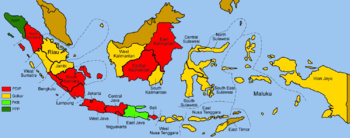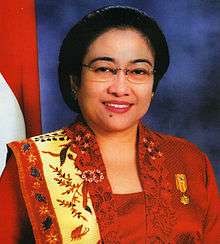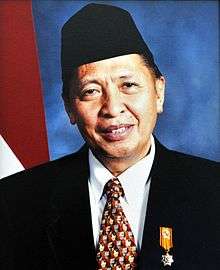1999 Indonesian legislative election
The 1999 Indonesian legislative election, held on 7 June 1999, was the first election since the end of the New Order and the first free election in Indonesia since 1955. With the ending of restrictions on political activity following the fall of Suharto, a total of 48 parties contested the 462 seats up for election in the People's Representative Council. A further 38 seats were reserved for the armed forces.
| |||||||||||||||||||||||||||||||||||||||||||||||||||||||||||||||||||||||||||||
462 (of 500) seats of the People's Representative Council | |||||||||||||||||||||||||||||||||||||||||||||||||||||||||||||||||||||||||||||
|---|---|---|---|---|---|---|---|---|---|---|---|---|---|---|---|---|---|---|---|---|---|---|---|---|---|---|---|---|---|---|---|---|---|---|---|---|---|---|---|---|---|---|---|---|---|---|---|---|---|---|---|---|---|---|---|---|---|---|---|---|---|---|---|---|---|---|---|---|---|---|---|---|---|---|---|---|---|
| |||||||||||||||||||||||||||||||||||||||||||||||||||||||||||||||||||||||||||||
| |||||||||||||||||||||||||||||||||||||||||||||||||||||||||||||||||||||||||||||
 |
|---|
| This article is part of a series on the politics and government of Indonesia |
|
|
Background
Under the New Order, only two political parties forcibly merged in 1973 plus the functional group 'Golkar' had been allowed to participate in elections.[1][2] With the start of the Reform Era, more than 100 new political parties emerged.[3] New elections were called for 1999 and 148 parties registered with the Ministry of Justice and Human Rights. Of these, only 48 passed the selection process, overseen by intellectual Nurcholish Madjid[4][5] The elections were to be overseen by an independent General Elections Commission (KPU) of 53 members, one from each party and five government representatives[6]
Electoral system
The system used was based on proportional representation at the provincial level. Within each province, parties were awarded seats in proportion to their share of the vote. The East Java province had the most number of seats, with 82, while the lowest was in Bengkulu and East Timor with four each. Voters chose parties, not people as the candidate list was closed, meaning the decision as to who would sit in the legislature was decided by the parties.[7]
Campaign

The official election campaign began on 19 May 1999 and ended on 4 June to allow two 'rest days' before the vote itself. It was divided into three stages, with different parties being allowed to campaign on different days.[8] However, before the campaign, there was violence between supporters of rival parties. Four people were killed in fighting between followers of the United Development Party and the National Awakening Party on 1 May and three more died in clashes between Golkar and Indonesian Democratic Party-Struggle supporters on 11 May.[9][10][11]
On the first day of the campaign, there was a parade of party vehicles in Central Jakarta. The Golkar float was attacked and damaged[12] The traffic circle in front of the Hotel Indonesia was a popular spot for rallies.[13][14][15] Meanwhile, there was an increase of people heading for Singapore to escape possible violence as polling day neared, with one newspaper reporting that more than 78,000 people had left.[16]
As well as rallies, the major parties took out full-colour advertisements in newspapers. Each party was also given air time TV for statements by lone spokespeople. There were also ads in the newspapers urging people to use their vote.[17][18]
In the final week, the main parties held huge rallies in the capital: the National Awakening Party on 1 June, the National Mandate Party on 2 June, the Indonesian Democratic Party-Struggle on 3 June and Golkar on 4 June, at which its supporters were attacked.[18][19][20][21]
At one minute past midnight on 5 June, all party flags, banners and posters began to be removed as the campaign officially ended. International observers continued to arrive to oversee the election, among them former US president Jimmy Carter.[11][21]
Polling day
In the last few days before the vote on 7 June, newspapers carried advertisements sponsored by the Indonesian Election Committee explaining how to vote and urging people to do so.[22]
On the day itself, polls opened at 8 am. People cast their vote by piercing the party symbol on the ballot paper and then dipped a finger in indelible ink to prevent repeat voting. When the votes were counted, each ballot paper was held up for onlookers to see.[23][24]
There was independent monitoring down to the level of polling stations by Indonesians as well as by 100 observers and support staff from 23 counties led by Jimmy Carter.[23] On polling day, Carter said that it would have been extremely difficult to manipulate the election data because of the well-prepared information network and because the information was easy to access.[25] One way the public could access the latest results was by sending a Short message service text to a specific number. The sender then received information about provincial or party results.[26]
On 9 June, Carter's team reported that although there had been "shortcomings" and allegations of financial abuses, they did not appear to have had a significant impact on the polling day activities.[27]
Results

The count was slow, with votes taking several weeks to count. Before he left Indonesia, Carter expressed his concern about this [28] At a meeting at the General Election Commission building on 26 June, only 22 of the 53 members of the commission were prepared to accept the result. These comprised the representatives of 17 of the parties (with 93% of the vote between them) and the five government representatives. Eventually, later that same day President Jusuf Habibie in a live TV broadcast declared the results were valid. The Indonesian Democratic Party-Struggle led by Megawati Sukarnoputri had won the largest share of the vote with Golkar in second place.
The process of allocating seats in the People's Representative Council took several months The Indonesian Election Committee (PPI)announced the results on 1 September. A total of 21 parties had won seats, with the Indonesian Democratic Party-Struggle being awarded 153 and Golkar 120. There were ten parties with only one seat each.[29]
| Parties | Votes | % | Seats | % | +/− |
|---|---|---|---|---|---|
| Indonesian Democratic Party – Struggle (Partai Demokrasi Indonesia Perjuangan, PDI–P) | 35,689,073 | 33.74 | 153 | 33.12 | n/a |
| Golkar (Partai Golongan Karya) | 23,741,749 | 22.44 | 120 | 25.97 | −205 |
| National Awakening Party (Partai Kebangkitan Bangsa, PKB) | 13,336,982 | 12.61 | 51 | 11.03 | n/a |
| United Development Party (Partai Persatuan Pembangunan, PPP) | 11,329,905 | 10.71 | 58 | 12.55 | −31 |
| National Mandate Party (Partai Amanat Nasional, PAN) | 7,528,956 | 7.12 | 34 | 7.36 | n/a |
| Crescent Star Party (Partai Bulan Bintang, PBB) | 2,049,708 | 1.94 | 13 | 2.81 | n/a |
| Justice Party (Partai Keadilan, PK) | 1,436,565 | 1.36 | 7 | 1.51 | n/a |
| Justice and Unity Party (Partai Keadilan dan Persatuan, PKP) | 1,065,686 | 1.01 | 4 | 0.87 | n/a |
| Nahdlatul Ummat Party (Partai Nahdlatul Ummat, PNU) | 679,179 | 0.64 | 5 | 1.08 | n/a |
| United Party (Partai Persatuan) | 655,052 | 0.62 | 1 | 0.22 | n/a |
| Love the Nation Democratic Party (Partai Demokrasi Kasih Bangsa, PDKB) | 550,846 | 0.52 | 5 | 1.08 | n/a |
| Indonesian Masyumi Islamic Political Party (Partai Politik Islam Indonesia Masyumi, Masyumi) | 456,718 | 0.43 | 1 | 0.22 | n/a |
| People's Sovereignty Party (Partai Daulat Rakyat, PDR) | 427,854 | 0.40 | 2 | 0.43 | n/a |
| Indonesian National Party (Partai Nasional Indonesia, PNI) | 377,137 | 0.36 | 0 | 0.00 | n/a |
| Indonesian Islamic Union Party (Partai Syarikat Islam Indonesia, PSII) | 375,920 | 0.36 | 1 | 0.22 | n/a |
| Indonesian National Christian Party (Partai Kristen Nasional Indonesia, Krisna) | 369,719 | 0.35 | 0 | 0.00 | n/a |
| Indonesian National Party – Marhaenist Front (Partai Nasional Indonesia – Front Marhaenis, PNI–Front Marhaenis) | 365,176 | 0.35 | 1 | 0.22 | n/a |
| Indonesian Unity in Diversity Party (Partai Bhinneka Tunggal Ika Indonesia, PBI) | 364,291 | 0.34 | 1 | 0.22 | n/a |
| Indonesian Democratic Party (Partai Demokrasi Indonesia, PDI) | 345,720 | 0.33 | 2 | 0.43 | −9 |
| Indonesian National Party – Marhaen Masses (Partai Nasional Indonesia – Massa Marhaen, PNI–Massa Marhaen) | 345,629 | 0.33 | 1 | 0.22 | n/a |
| League of Supporters of Indonesian Independence Party (Partai Ikatan Pendukung Kemerdekaan Indonesia, IPKI) | 328,654 | 0.31 | 1 | 0.22 | n/a |
| Community Awakening Party (Partai Kebangkitan Umat, PKU) | 300,064 | 0.28 | 1 | 0.22 | n/a |
| Indonesian Muslim Awakening Party (Partai Kebangkitan Muslim Indonesia, Kami) | 289,489 | 0.27 | 0 | 0.00 | n/a |
| Islamic Community Party (Partai Ummat Islam, PUI) | 269,309 | 0.25 | 0 | 0.00 | n/a |
| Democratic Catholic Party (Partai Katolik Demokrat, PKD) | 216,675 | 0.20 | 0 | 0.00 | n/a |
| Aceh Orphans' Foundation Party (Partai Abul Yatama, PAY) | 213,979 | 0.20 | 0 | 0.00 | n/a |
| Republican Party (Partai Republik) | 208,157 | 0.20 | 0 | 0.00 | n/a |
| Familial Consultative Party of Mutual Assistance (Partai Musyawarah Kekeluargaan Gotong Royong, MKGR) | 204,204 | 0.19 | 0 | 0.00 | n/a |
| New Indonesia Party (Partai Indonesia Baru, PIB) | 192,712 | 0.18 | 0 | 0.00 | n/a |
| Indonesian National Solidarity Party (Partai Solidaritas Uni Nasional Indonesia, SUNI) | 180,167 | 0.17 | 0 | 0.00 | n/a |
| Love and Peace Party (Partai Cinta Damai, PCD) | 168,087 | 0.16 | 0 | 0.00 | n/a |
| Indonesian Islamic Union Party – 1905 (Partai Syarikat Islam Indonesia – 1905, PSII–1905) | 152,820 | 0.14 | 0 | 0.00 | n/a |
| New Masyumi Party (Partai Masyumi Baru, PMB) | 152,589 | 0.14 | 0 | 0.00 | n/a |
| National Party of the Indonesian Nation (Partai Nasional Bangsa Indonesia, PNBI) | 149,136 | 0.14 | 0 | 0.00 | n/a |
| Indonesian Democratic Union Party (Partai Uni Demokrasi Indonesia, PUDI) | 140,980 | 0.13 | 0 | 0.00 | n/a |
| National Labor Party (Partai Buruh Nasional, PBN) | 111,629 | 0.11 | 0 | 0.00 | n/a |
| National Freedom Party (Partai Kebangsaan Merdeka, PKM) | 104,385 | 0.10 | 0 | 0.00 | n/a |
| Democratic National Party (Partai Nasional Demokrat, PND) | 96,984 | 0.09 | 0 | 0.00 | n/a |
| Indonesian Democratic Alliance Party (Partai Aliansi Demokrat Indonesia, PADI) | 85,838 | 0.08 | 0 | 0.00 | n/a |
| Democratic People's Party (Partai Rakyat Demokratik, PRD) | 78,727 | 0.07 | 0 | 0.00 | n/a |
| Indonesian Workers' Party (Partai Pekerja Indonesia, PPI) | 63,934 | 0.06 | 0 | 0.00 | n/a |
| Democratic Islamic Party (Partai Islam Demokrat, PID) | 62,901 | 0.06 | 0 | 0.00 | n/a |
| Great People's Consultative Party (Partai Musyawarah Rakyat Banyak, Murba) | 62,006 | 0.06 | 0 | 0.00 | n/a |
| All-Indonesia Workers' Solidarity Party (Partai Solidaritas Pekerja Seluruh Indonesia, PSPSI) | 61,105 | 0.06 | 0 | 0.00 | n/a |
| Indonesian People's Party (Partai Rakyat Indonesia, Pari) | 54,790 | 0.05 | 0 | 0.00 | n/a |
| Indonesian Muslim Community Party (Partai Umat Muslimin Indonesia, PUMI) | 49,839 | 0.05 | 0 | 0.00 | n/a |
| Workers' Solidarity Party (Partai Solidaritas Pekerja, PSP) | 49,807 | 0.05 | 0 | 0.00 | n/a |
| People's Choice Party (Partai Pilihan Rakyat, Pilar) | 40,517 | 0.04 | 0 | 0.00 | n/a |
| Total | 105,786,661 | 100.00 | 462 | 100.00 | +37 |
| Source: KPU[30]Note: Seat change numbers are displayed only for parties which stood in the previous election. | |||||
October 1999 executive branch election
In October, the People's Consultative Assembly made up of the People's Representative Council and 200 nominated members from the military and selected civilians, a total of 700, met to elect the president and vice president. This was the last indirect presidential election in Indonesia and the first presidential election that did not feature a candidate from ruling-party (Golkar). On 20 October, Abdurrahman Wahid, known as Gus Dur, chairman of the National Awakening Party was elected, beating Megawati Sukarnoputri by 373 votes to 313, although her Indonesian Democratic Party of Struggle won the most votes in the legislative election and thus had one-third of the parliamentary seats. This triggered riots among Megawati's supporters. The following day, Megawati was nominated by Gus Dur's party as vice president and got elected, beating Hamzah Haz from the United Development Party by 396 votes to 284. This ended the street protests.[31][32]
Presidential election result
| Candidate | Party | Votes | % | Image |
|---|---|---|---|---|
| Abdurrahman Wahid | National Awakening Party | 373 | 53.98 |  |
| Megawati Sukarnoputri | Indonesian Democratic Party of Struggle | 313 | 45.30 |  |
| Invalid votes | 5 | 0.72 | ||
| Total | 691 | 100 | ||
| Registered electors/turnout | 700 | 98.71 | ||
Vice presidential election result
| Candidate | Party | Votes | % |
|---|---|---|---|
| Megawati Sukarnoputri | Indonesian Democratic Party of Struggle | 396 | 57.81 |
| Hamzah Haz | United Development Party | 284 | 41.46 |
| Invalid votes | 5 | 0.73 | |
| Total | 685 | 100 | |
| Registered electors/turnout | 700 | 97.86 | |
References
- Ananta, Aris; Arifin, Evi Nurvidya & Suryadinata, Leo (2004), Indonesian Electoral Behaviour: A Statistical Perspective, Indonesia's Population Series, Singapore: Institute of Southeast Asian Studies, ISBN 978-981-230-224-3, retrieved 2009-06-06.
- Ananta, Aris; Arifin, Evi Nurvidya & Suryadinata, Leo (2005), Emerging Democracy in Indonesia, Singapore: Institute of Southeast Asian Studies, ISBN 978-981-230-322-6, retrieved 2009-06-05.
- Evans, Kevin Raymond, (2003) The History of Political Parties & General Elections in Indonesia, Arise Consultancies, Jakarta, ISBN 978-979-97445-0-0
- Friend, Theodore (2003) Indonesian Destinies, The Belknap Press of Harvard University Press, ISBN 978-0-6740113-7-3
- Loveard, Keith, (1999) Suharto: Indonesia's Last Sultan, Horizon Books, Singapore, ISBN 978-981-04-1478-8
- Liddle, R. William, The 1977 Indonesian and New Order Legitimacy, South East Asian Affairs 1978, Translation published in Pemilu-Pemilu Orde Baru, LP3ES, Jakarta, ISBN 978-979-8015-88-5
- Partai Partai Politik Indonesia: Ideologi, Strategi, dan Program (in Indonesian), Jakarta: Kompas, 1999, ISBN 978-979-9251-00-8.
- (in Indonesian) Salomo Simanungkalit et al. (Eds) (2004) Peta Politik Pemilhan Umum 1999-2004 (Political Map of General Elections 1999-2004) Buku Kompas, Jakarta ISBN 978-979-709-114-9
Notes
- Liddle (1978) p40
- Evans (2003) pp. 21-21
- Evans (2003) p28
- Friend (2003) p406
- Salomo et al.(2004) p.xxxv
- Kompas 27 July 1999
- Evans (2003) pp. 126-127
- Kompas 29 April 1999 p40
- Kompas 2 May 1999
- Sinar Indonesia Baru 12 May 1999
- Kompas 6 June 1999
- Kompas 20 May 1999
- Kompas 24 May 1999
- Kompas 1 June 1999
- Friend (2003) p412
- Sinar Indonesia Baru 30 May 1999
- Friend (2003) p408
- Kompas 3 June 1999
- Kompas 2 June 1999
- Kompas 4 June 1999
- Kompas 5 June 1999
- Kompas 3, 5 & 5 June 1999
- Friend (2003) p415
- Evans (2003) p203
- Media Indonesia 8 June 1999
- Kompas 7 June 1999
- Friend (2003) p417
- Friend (2003) pp. 417, 424
- Kompas 2 September 1999
- Sekretariat Jenderal KPU (2010). Pemuilu untuk Pemula: Modul 1 (PDF). Komisi Pemilihan Umum.
- Friend (2003) pp. 461 - 462
- Ricklefs, M.C (2008). A History of Modern Indonesia Since c. 1200 (Fourth ed.). Palgrave Macmillan. p. 539. ISBN 978-0-230-54685-1.


.jpg)


